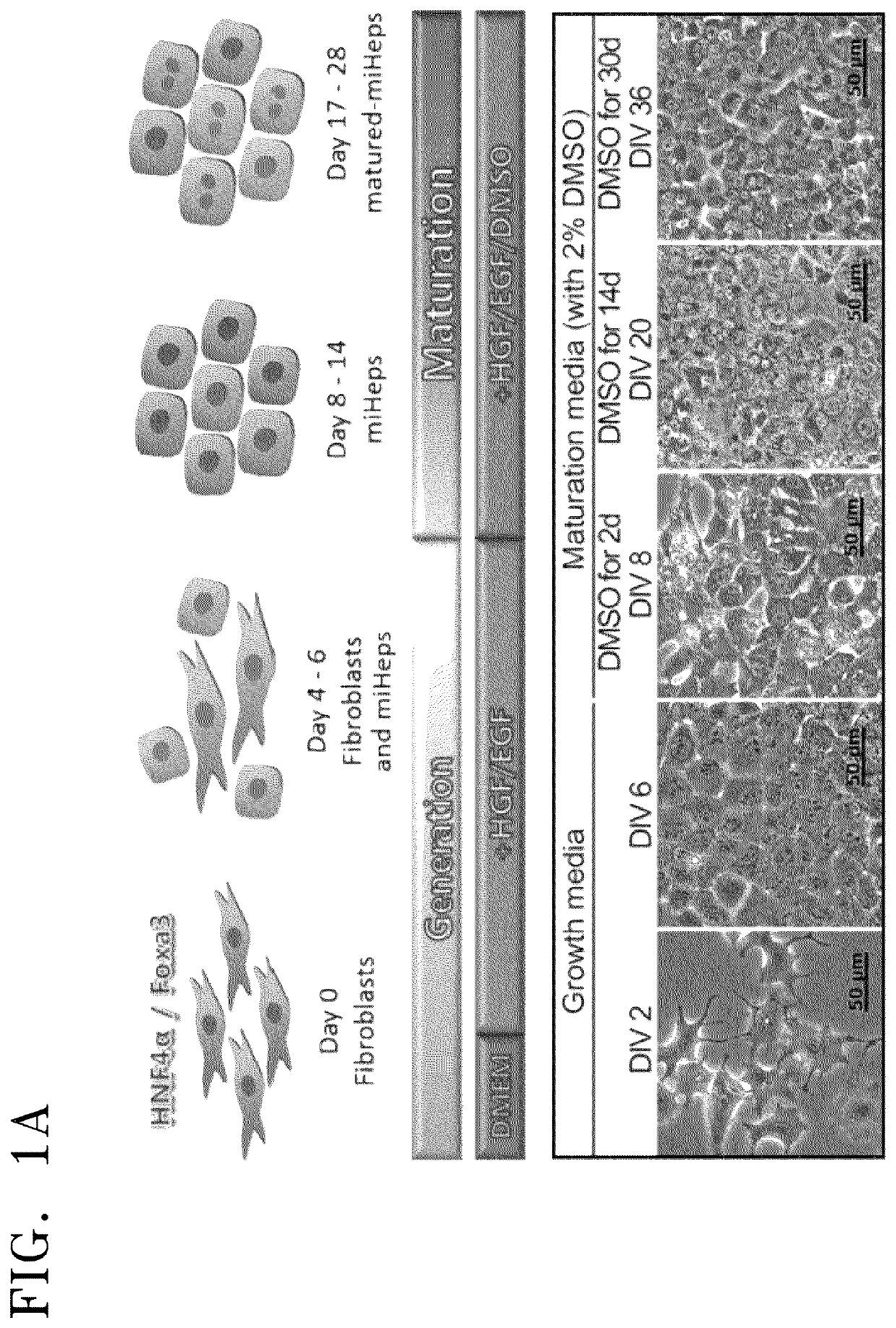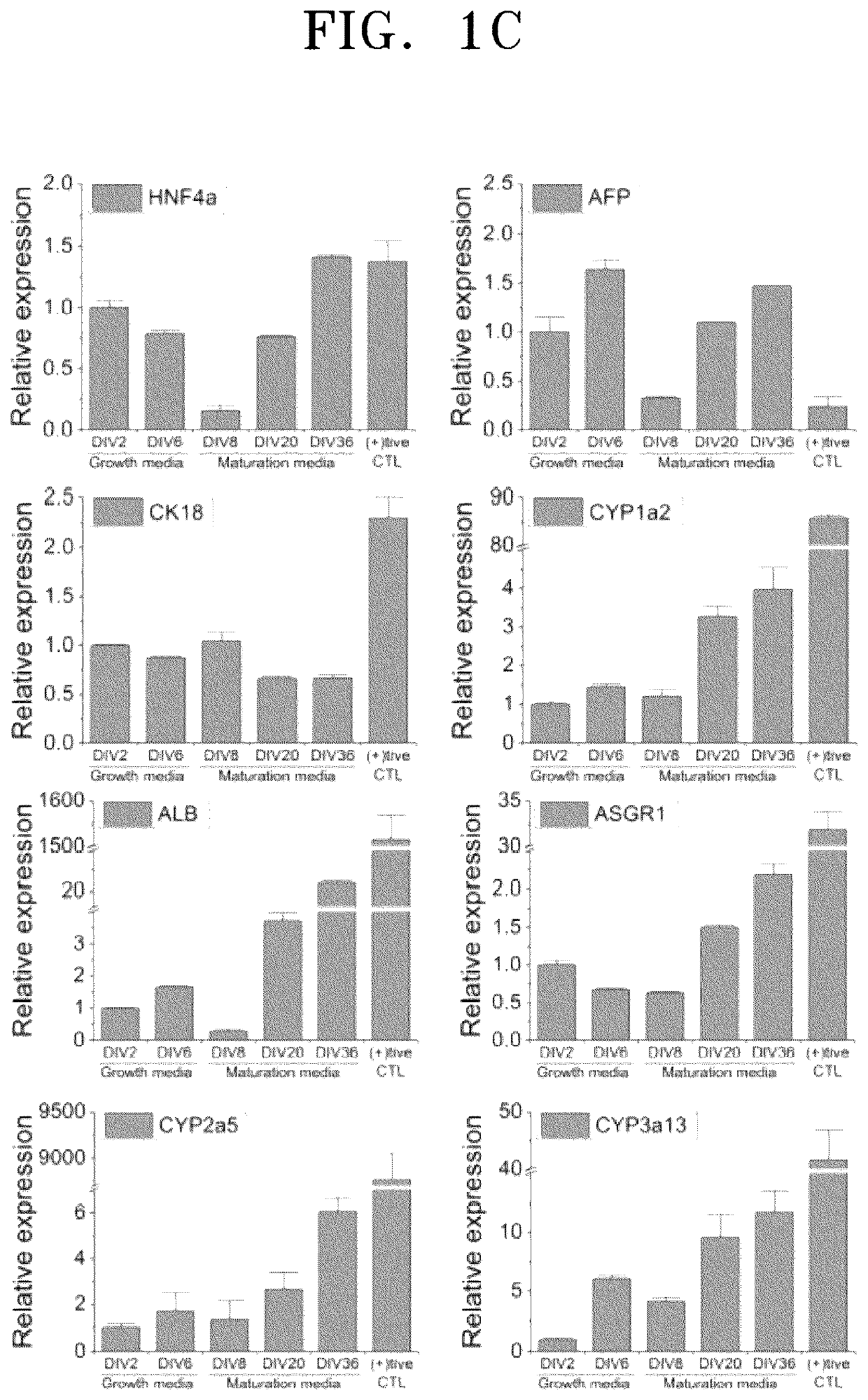Method of preparing three-dimensional cell spheroid including adipose-derived stem cells and hepatocytes
a cell spheroid and adipose-derived stem cells technology, applied in the field of three-dimensional cell spheroid preparation, can solve the problems of reduced differentiation and replication ability, cell loss and contamination, and the inability to obtain a large number of cells using the two-dimensional culture method, and achieve the effect of improving hepatic functions
- Summary
- Abstract
- Description
- Claims
- Application Information
AI Technical Summary
Benefits of technology
Problems solved by technology
Method used
Image
Examples
example
Example 1. Direct Induction of Hepatocyte Phenotype from Mouse Induced Hepatic Progenitor
[0059]To obtain a large amount of mature hepatocytes which are required in the liver tissue engineering, mouse induced hepatic progenitors (miHeps) directly trans-differentiated from mouse embryonic fibroblast (MEF) were used. In detail, the cells were obtained by introducing, using a pMX viral vector, two factors of Foxa3 and HNF4a, which are known to hepatocyte-specific upstream regulating factors, into MEFs which were obtained by primary culture in E16.5 mouse.
[0060]Fibroblasts were cultured in a DMEM medium for 3 days, and then miHep were seeded at a density of 2×104 cells / cm2 and cultured in a hepatocyte growth medium containing 20 ng / ml of HGF and 20 ng / ml of EGF for 7 days. Thereafter, the miHeps were isolated and cultured in a hepatocyte maturation medium containing 20 ng / ml of HGF, 20 ng / ml of EGF, and 2% DMSO 2% volume / volume (medium) for 7 days to 28 days.
[0061]To verify hepatocyte-sp...
example 2
ation of Hepatocyte-Specific Marker Expression of Three-Dimensional Cell Spheroid
[0078]Expression of hepatocyte-specific markers of the three-dimensional cell spheroid (hASC-miHep organoid) prepared in Example 1-3, miHeps of Example 1-1, and the two-dimensional cell spheroid (hASC-miHep organoid) prepared in Comparative Example 1 was analyzed by RT-PCR and real-time PCR. Media for miHeps are divided into a growth medium that preferentially promotes cell division so as to enable large-scale culture during a culturing process and a maturation medium that induces cell maturation while suppressing division. Therefore, miHeps were cultured under the respective conditions and divided into two different miHeps which are different in maturity. In detail, from the cell spheroid prepared using immature miHeps cultured in the hepatocyte maturation medium of Example 1 and the cell spheroid prepared using mature miHeps obtained in Example 1, total RNAs were extracted and purified at 2 days after...
example 3
ization of Culture Medium of Three-Dimensional Cell Spheroid
[0081]To examine whether ambivalent modulation of hepatocyte-specific gene expression according to the maturity of miHeps in the co-cultured hASC-miHep organoid is attributed to factors secreted by hASCs, immature or mature miHeps cultured under two dimensional conditions were treated with conditioned medium (CM) obtained from hASCs which were cultured under two- or three-dimensional conditions. Media used in the two- or three-dimensional culture to obtain the conditioned medium were all CB-ADMSC-GM of CEFO Co. Ltd., and the adipose-derived stem cells obtained in Example 2-1 were seeded at a density of 1.0×105 cells / cm2 in a 98-well tissue culture plate (TCP) or a 98-well non-tissue culture plate (NTCP) coated with MBP-FGF2, and additionally cultured for one day, thereby obtaining the tissue culture media. Thereafter, hepatocyte-specific gene expression of miHeps was examined by RT-PCR and real-time PCR. Further, to visuali...
PUM
| Property | Measurement | Unit |
|---|---|---|
| diameter | aaaaa | aaaaa |
| diameter | aaaaa | aaaaa |
| diameter | aaaaa | aaaaa |
Abstract
Description
Claims
Application Information
 Login to View More
Login to View More - R&D
- Intellectual Property
- Life Sciences
- Materials
- Tech Scout
- Unparalleled Data Quality
- Higher Quality Content
- 60% Fewer Hallucinations
Browse by: Latest US Patents, China's latest patents, Technical Efficacy Thesaurus, Application Domain, Technology Topic, Popular Technical Reports.
© 2025 PatSnap. All rights reserved.Legal|Privacy policy|Modern Slavery Act Transparency Statement|Sitemap|About US| Contact US: help@patsnap.com



